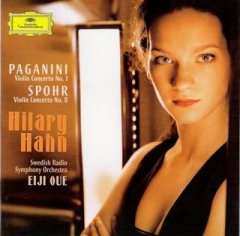Louis Spohr – Violin Concerto no.8 (Hilary Hahn) [2006]
Louis Spohr – Violin Concerto no.8 (Hilary Hahn) [2006]

1) 1. Recitative - Allegro molto [4:05] 2) 2. Adagio - Andante [7:44] 3) 3. Allegro moderato [8:03] Hilary Hahn Swedish Radio Symphony Orchestra Eije Oue - conductor
Composed in 1816, Spohr’s Violin Concerto No. 8 received its Carnegie Hall premiere on December 4, 1896, with Carl Halir, violin, and the New York Symphony Orchestra conducted by Walter Damrosch. Louis (or Ludwig) Spohr was an extremely accomplished violinist and composer, in his time more famous in some circles than the other Ludwig—Beethoven. Spohr towered over other men and was said to have the hands of an athlete. Born within two years of Paganini, he came to regard the great Italian virtuoso as his arch-nemesis. He shunned the sensational effects of Paganini, preferring to use the violin as a vehicle for profound and lasting expression. In his 15 concertos, he strove to display his virtuosity without sacrificing his artistic standards.
He composed his Concerto No. 8, “in the form of an operatic scene,” in anticipation of his concerts in Italy, which he knew to be “voice mad.” In his autobiography, he revealed how he appealed to the crowd at Milan’s La Scala with his “singing” concerto:
It is difficult … with only the violin, to appeal to an audience accustomed to voices … Uncertainty about how my playing and my compositions would please the Italians left me somewhat anxious … but with the first measures I noted that the audience was receptive. My anxiety disappeared, and I played without inhibition. I also noted with pleasure that with my new concerto, written in Switzerland in the form of a scena ed aria, I had hit the mark. The arioso passages were received with particular enthusiasm.
Spohr’s goal of making the violin sing is obvious from the very first entry of the soloist, which is marked “Recitative.” The operatic nature of the violin’s melody draws attention to the proximity of the violin’s voice to that of a prima donna soprano. (Elsewhere, Spohr highlighted a different quality of the violin: in his programmatic “Travel” Sonata, Op. 96, for example, he made it sing, believe it or not, like a castrato.) In the ensuing cavatina and cabaletta, which follow without a break, the instrument’s vocality is further displayed, as if to demonstrate the statement Spohr made in his treatise on violin playing, that “of all instruments, the violin comes closest to the human voice.”
The concerto was a great success with the Italians, who appreciated Spohr’s instrumental vocalise. Interestingly, when he performed this concerto elsewhere, he was praised not only for approximating singing but for going beyond what the human voice could do. In London and Berlin, Spohr’s violin was thought to be so expressive as to out-sing many opera singers of the day. ---violinist.com
download: uploaded yandex 4shared mediafire solidfiles mega filecloudio nornar gett ziddu
Last Updated (Sunday, 30 March 2014 13:58)








